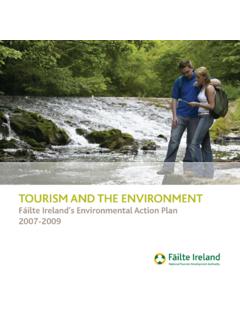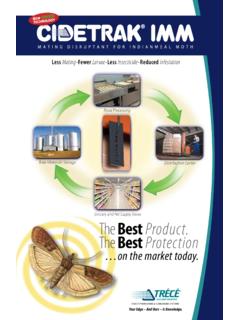Transcription of Dragonflies & Damselflies - Notice Nature
1 Information on the environment / eolas ar an gcomhshaolWILDLIFEit s easy | to make a 37 Dragonflies & DamselfliesDragonflies and Damselflies areamong the largest and mostcolourful insects seen in thewetlands of Ireland. They arecarnivorous and can hunt prey whileflying about. They breed in water. Theeggs hatch into a brown nymphwhich spends up to four years in thewater before emerging as thecolourful adult. Adult Dragonflies anddamselfies are insects of summerliving for a few weeks. There are 28species of dragonfly and damselfly inIreland which includes both residentand migrant are Dragonflies &Damselfies? Dragonflies and Damselflies are largeor moderate sized predaceousinsects.
2 The body is long, oftenslender. The head is big with verylarge and prominent eyes. Theantennae are thin and very have four wings which areapproximately the same size. Thewings are membraneous with manyveins. They have six legs with are also found on the tail endof males for clasping of Dragonflies anddamselflies are and DamselflyTaxonomy Dragonflies and Damselflies areinsects belonging to the OrderOdonata. There are two distinct suborders: The Zygoptera are thedamselflies and the Anisoptera arethe Dragonflies . In Ireland we have 17dragonfly species and 11 CycleThe mating of adults can take placein flight, on the ground or amongvegetation depending on the openings of the male and femalegenetalia are at at widely separatedparts of the body.
3 This means thatstrange contortions of the bodies areneeded to bring about fertilisation ofthe eggs. The male has special analclaspers which are used for grippingthe female in the back of the head orneck thus allowing the bodies tocome into close contact forfertilisation of the eggs are laid in water,sometimes inside plant stems. Thefemales of some species penetratebelow the surface for egg-laying, andare helped in doing this by the male,who remains above the surface andkeeps a firm grasp on the and damselfly nymphs arecarnivorous, posessing a mask consisting of impaling mandibles, orhooks on an extensible limb, which isused for bringing the food to themouth and for holding it there.
4 The mask is shot out with lighteningspeed when prey of suitable sizeapproaches within reach, and thenymph may also dart forward toseize its victim, but at other timesthe creature is metamorphosis isincomplete in the Dragonflies anddamselfies, the fully grown nymphsdo not bear a close resemblance tothe adult NymphA Dragonfly Nymph has a heavy body, three pairs of legs,large eyes and wing buds. Nymphs range in size to withhookscompound eyeStructure of a Dragonflyabdomenwinganal hooks forgripping femalesthoraxheadmouth maskwings of a dragonfly are differentshapes. The fore wings have narrowbases while the hind wings are wideat the aquatic nymphs of dragonfliesand Damselflies are also of the Damselflies have threetail like projections.
5 These are gills,and are absent in dragonfly group of Damselflies that areeasy to distinguish are thedemoiselles or jewelwings. Thesehave large coloured patches on theirwings, a little like a butterfly. Otherdamselflies have really colourfulbodies - red, bright blue or emeraldgreen. To identify these to anindividual species you need the helpof a book or identification chart (seeField Guides).You can begin to identify dragonfliesby recognising five different biggest Dragonflies found inIreland are the Emperors which arebetween 7 and 8cm long. These arepowerful insects and seeminglytireless in flight. Look out for theBlue Emperor (Anax imperator) insouthern coastal wetlands ofIreland.
6 Male Emperor s have anamazing blue body while femaleshave an apple green body. Thisit is the conditions the larva needwhich determine where the specieswill be found. Lakes, turloughs, bogsand fens are amongst the bestplaces for these insects in Ireland,supporting both large numbers ofspecies including some of the rarestIrish species and large populations ofindividual and Damselflies prefersheltered ponds with waterunaffected by enrichment in whichthe larvae will live, with few if anyfish, as these are predators ofdragonfly and damselfly larvae. Adultdragonflies and Damselflies requiregood feeding areas so sites withadditional habitats such aswoodland, scrub or unimprovedgrassland and wetland vegetationclose to breeding sites will supportthe strongest dragonfly anddamselfly Dragonflies &DamselfiesThe first task in identifyingdragonflies and damselfies is toseparate a dragonfly from a are big and acrobatic inflight.
7 They like to attract are small and dainty andonly fly short distances. They mightremind you of a cranefly or daddylong-legs, as they flit about. Anotherdifference between the two insectsis that a dragonfly resting or feedingholds its four wings straight outfrom its body. Damselflies at resthold their wings folded or slighltyspread, but close to their fore and hind wings of adamselfly are the same shape. Theyall have narrow bases at the point ofattachment to the abdomen. TheThe nymph leaves the water after alarval period of about two years in thecase of the damselfies and three yearsin that of the Dragonflies . It thenclimbs up a reed or other projectionabove the surface.
8 Here the finaltransformation takes place, thenymphal skin splits and the imagowriggles out. The wings then expandand the abdomen becomes elongateand slender; the colouration takes acertain time to develop, and thiswaiting or teneral period may last forseveral of Dragonflies &DamselfliesAs most of a dragonfly or damselflylifecycle is spent as an aquatic larvawhich can last for two to four years,WILDLIFE / Dragonflies and Damselflies / WL 37legs withhooks to holdpreywings forflightheadextendiblemouth maskthoraxlong slender abdomenStructure of a Damselflycompound eyeDamselfly NymphA Damselfly Nymph has a long body, three pairs of legs,four developing wings, and three leafy gills at the end ofthe tail.
9 Nymphs range in size from 2cm to Life CycleThe Dragonfly Life Cycle can takeup to four years to complete. Theegg hatches into the aquaticnymph which emerges from thepond as the colourful the base of its hind wings next toits darters include four bright redspecies and one black species. Theskimmers have blue bodies. Onceagain, to sort these out you need thehelp of a book or identification chart(see Field Guides).Threats to Dragonflies andDamselfiesWith the loss of bogs and fens andthe eutrophication of waterways, ourdragonfly and damselfly species areundoubtedly in decline. Two speciesin particular are of concern. The IrishDamselfly or Irish Bluet(Coenagrionlunulatum) is a very local speciesfound on mesotrophic lakes, fens andcutover bogs.
10 Some 30 colonies areknown mostly in Armagh,Fermanagh, Monaghan and this species was onlyfound in Ireland some twenty yearsago, already some colonies appear tohave been lost. Eutrophication ofsites is believed to have been themain status of our rarest Irish dragonflythe Northern or Moorland Emerald(Somatochlora arctica)is also ofconcern as it is apparently confined tothe Killarney National Park in Here it breeds in shallow poolsin bogs. However it is an elusive insectwhich has been rarely seen and thereare few known breeding sites. TheNorthern Emerald is threatened byhabitat change and also by longer-term climate change as it is, like manyof our bog dwelling insects, anorthern, cold-adapted You Can DoCreate a dragonfly haven in yourgarden by building a pond.










